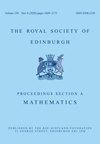On the global existence of solutions to chemotaxis system for two populations in dimension two
IF 0.9
3区 数学
Q1 MATHEMATICS
Proceedings of the Royal Society of Edinburgh Section A-Mathematics
Pub Date : 2023-01-09
DOI:10.1017/prm.2022.88
引用次数: 0
Abstract
We consider the global existence for the following fully parabolic chemotaxis system with two populations \[\left\{ \begin{array}{@{}ll} \partial_tu_i=\kappa_i\Delta u_i-\chi_i\nabla\cdot(u_i\nabla v),\quad i\in\{1,2\}, & x\in\Omega,\ t>0, \\ v_t=\Delta v-v+u_1+u_2, & x\in\Omega,\ t>0,\\ u_i(x,t=0)=u_{i0}(x),\quad v(x,t=0)=v_0(x), & x\in\Omega, \end{array} \right. \] where $\Omega =\mathbb {R}^2$ or $\Omega =B_R(0)\subset \mathbb {R}^2$ supplemented with homogeneous Neumann boundary conditions, $\kappa _i,\chi _i>0,$ $i=1,2$ . The global existence remains open for the fully parabolic case as far as the author knows, while the existence of global solution was known for the parabolic-elliptic reduction with the second equation replaced by $0=\Delta v-v+u_1+u_2$ or $0=\Delta v+u_1+u_2$ . In this paper, we prove that there exists a global solution if the initial masses satisfy the certain sub-criticality condition. The proof is based on a version of the Moser–Trudinger type inequality for system in two dimensions.二维两种群趋化系统解的整体存在性
我们考虑以下具有两个种群\[\left\{ \begin{array}{@{}ll} \partial_tu_i=\kappa_i\Delta u_i-\chi_i\nabla\cdot(u_i\nabla v),\quad i\in\{1,2\}, & x\in\Omega,\ t>0, \\ v_t=\Delta v-v+u_1+u_2, & x\in\Omega,\ t>0,\\ u_i(x,t=0)=u_{i0}(x),\quad v(x,t=0)=v_0(x), & x\in\Omega, \end{array} \right. \]的完全抛物型趋化系统的整体存在性,其中$\Omega =\mathbb {R}^2$或$\Omega =B_R(0)\subset \mathbb {R}^2$补充了齐次Neumann边界条件$\kappa _i,\chi _i>0,$$i=1,2$。据笔者所知,对于完全抛物型情况,整体解的存在性是开的,而对于用$0=\Delta v-v+u_1+u_2$或$0=\Delta v+u_1+u_2$代替第二方程的抛物-椭圆型约简,整体解的存在性是已知的。本文证明了当初始质量满足一定的亚临界条件时,存在一个全局解。该证明基于二维系统的Moser-Trudinger型不等式的一个版本。
本文章由计算机程序翻译,如有差异,请以英文原文为准。
求助全文
约1分钟内获得全文
求助全文
来源期刊
CiteScore
3.00
自引率
0.00%
发文量
72
审稿时长
6-12 weeks
期刊介绍:
A flagship publication of The Royal Society of Edinburgh, Proceedings A is a prestigious, general mathematics journal publishing peer-reviewed papers of international standard across the whole spectrum of mathematics, but with the emphasis on applied analysis and differential equations.
An international journal, publishing six issues per year, Proceedings A has been publishing the highest-quality mathematical research since 1884. Recent issues have included a wealth of key contributors and considered research papers.

 求助内容:
求助内容: 应助结果提醒方式:
应助结果提醒方式:


